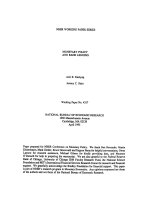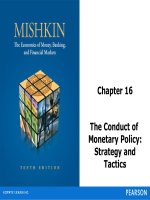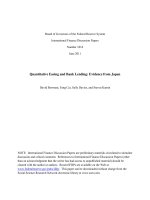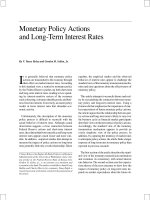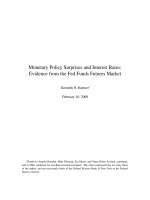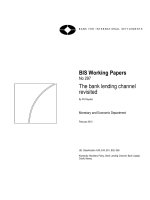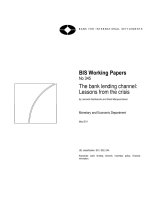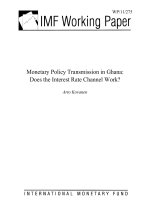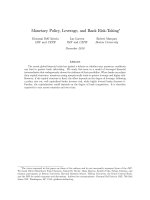Monetary policy transmission and bank lending channel in vietnam
Bạn đang xem bản rút gọn của tài liệu. Xem và tải ngay bản đầy đủ của tài liệu tại đây (3.87 MB, 311 trang )
i
MINISTRY OF EDUCATION AND TRAINING
UNIVERSITY OF ECONOMICS HO CHI MINH CITY
*****
NGUYEN PHUC CANH
MONETARY POLICY TRANSMISSION AND
BANK LENDING CHANNEL IN VIETNAM
PHD THESIS
HO CHI MINH CITY, 2016
ii
MINISTRY OF EDUCATION AND TRAINING
UNIVERSITY OF ECONOMICS HO CHI MINH CITY
*****
NGUYEN PHUC CANH
MONETARY POLICY TRANSMISSION AND
BANK LENDING CHANNEL IN VIETNAM
Major: Finance and Banking
Code: 62.34.02.01
PHD THESIS
ACADEMIC ADVISORS
1. Prof. Dr. SU DINH THANH
2. Assoc. Prof. Dr. VO XUAN VINH
HO CHI MINH CITY, 2016
i
ACKNOWLEDGEMENTS
I am deeply indebted to my academic advisers Pro.Dr. Sử Đình Thành and
Assoc.Pro.Dr. Võ Xuân Vinh for their fundamental roles. Pro.Thành and Pro.Vinh have
provided me with guidance, assistances, and supports during my study. They have given
me autonomy on decision making and researching the topic, while continuing to provide
valuable feedbacks, advices, and encouragement. In addition to our academic
collaboration, I greatly appreciate the bonding relationships between Thành, Vinh and
I. Additionally, I am deeply thankful to Dr. Trầm Thị Xuân Hương, my lecturer and my
researching partner at School of Banking, who has assisted me in researching the topic
in this thesis. She has also advised, encouraged and generously allowed me to apply our
shared works in presenting this thesis. I gratefully acknowledge lecturers from the
research methodology course at University of Economics Ho Chi Minh City who have
provided me with basis methodologies for this study. Such methodologies have helped
me understand, find and utilize correct methods.
I would like to thank my dear colleagues at School of Banking and University of
Economics Ho Chi Minh City for their substantial influence. The School of Banking
and University of Economics Ho Chi Minh City provide the best environment for
studying and researching. I also give my thanks to colleagues in International
department at School of Banking, they always supported and encouraged me in this
study and helped me a lot throughout my career. I also would like to thank the board of
professors and the independent external reviewers who gave me a lot of useful
comments and advices on my first presentation, their comments are one of the major
contributing factors that allowed me to complete this version of my thesis.
I am deeply thankful to my family for their love, support, and sacrifice. Without
them, this thesis would never have been written.
Ho Chi Minh City, Sep/2016
Nguyen Phuc Canh
ii
ABBREVIATIONS
Words
Meanings
ADB
Asia Development Bank
APC
Asset Price Channel
AR
Autoregression
ARDL
Autoregressive Distributed Lag Model
BLC
Bank Lending Channel
BSC
Balance Sheet Channel
BRICS
BRICS Group (including Brazil, Russia, India, China and
South Africa)
CC
Credit Channel
CFC
Cash Flow Channel
CPI
Consumer Price Index
DSGE
Dynamic Stochastic General Equilibrium Model
EC
Expectation Channel
ECB
European Central Bank
ECM
Error Correction Model
EDF
Expected Default Frequency
ERC
Exchange Rate Channel
E.U.
European Union
FAVAR
Factor Augmented Vector Autoregression
FDICIA
Federal Deposit Insurance Corporation Improvement Act
Fed
Federal Reserve System
FFR
Fed Fund Rate
GDP
Gross Domestic Production
GMM
Generalized Method of Moments
G7
Canada, France, Germany, Italy, Japan, UK, US
iii
HLE
Household Liquidity Effects
HNX
Hanoi Stock Exchange
HSX
Ho Chi Minh Stock Exchange
IRC
Interest Rate Channel
IS-LM
Investment, Saving–Liquidity Preference, Money Supply
IMF
International Monetary Fund
IPVN
Vietnam Industrial Production
IRF
Impulse Response Function
IT
Inflation Targeting Policy
LER
Lending Interest Rate
LIBOR
London Interbank Offer Rate
MPTM
Monetary Policy Transmission Mechanism
M2
Money Supply definition (expanded money supply)
NEER
Nominal Effective Exchange Rate
NPV
Net Present Value
OECD
Organization for Economic Co-operation and Development
OLS
Ordinary Least Squares
KMV EDF
KMV’s Expected Default Frequency
QE
Quantitative Easing program
RDR
Rediscounting Rate
RFR
Refinancing Rate
SBV
State Bank of Vietnam
SME
Small and Medium Enterprises
S&P 500
S&P 500 Index
SVAR
Structured Vector Autoregression
VAR
Vector Autoregression
VECM
Vector Error Correction Models
VIX
The implied volatility of S&P 500 index options
iv
VND
Vietnam Dong (Currency of Vietnam)
VNI
VNindex
VNIBOR
Vietnam Interbank Offer Rate
VNindex
Vietnam composite stock index
U.K.
The United Kingdom
UPLC
Unexpected Price Level Channel
U.S.
The United State
USD
US Dollar
WACC
Weighted Average Capital Cost
WTO
World Trade Organization
v
TABLE OF CONTENTS
ACKNOWLEDGEMENTS ......................................................................................... i
ABBREVIATIONS ...................................................................................................... ii
LIST OF TABLES ....................................................................................................... x
LIST OF FIGURES .................................................................................................. xiv
CHAPTER 1 ................................................................................................................. 1
INTRODUCTION ....................................................................................................... 1
1.1.
The overview of Vietnamese economy and monetary policy ...................... 1
1.1.1.
The Vietnamese economy ......................................................................... 1
1.1.2.
The State Bank of Vietnam ...................................................................... 2
1.1.3.
The Vietnamese monetary policy ............................................................. 3
1.1.4.1.
Market interest rates ........................................................................... 4
1.1.4.2.
Inflation ............................................................................................... 4
1.1.4.3.
Exchange rate ..................................................................................... 6
1.1.4.4.
Credit .................................................................................................. 6
1.1.4.5.
Stock markets ...................................................................................... 7
1.2.
Research gap identification ............................................................................ 8
1.3.
Research objectives and questions .............................................................. 10
1.4.
The scope of this study ................................................................................. 11
1.5.
Research methodologies and data ............................................................... 12
1.5.1.
Methodologies ......................................................................................... 12
1.5.2.
Research data .......................................................................................... 13
1.6.
Some key concepts ........................................................................................ 13
1.7.
The structure of study .................................................................................. 15
CHAPTER 2 ............................................................................................................... 17
vi
THEORETIAL FRAMEWORK AND LITERATURE REVIEW ....................... 17
2.1.
Monetary policy ............................................................................................ 17
2.1.1.
Introduction ............................................................................................ 17
2.1.2.
Central bank............................................................................................ 18
2.1.3.
Monetary policy targets .......................................................................... 18
2.1.4.
Monetary policy tools .............................................................................. 19
2.1.5.
The ineffectiveness of monetary policy .................................................. 20
2.1.6.
Monetary policy and fiscal policy........................................................... 20
2.1.7.
Unconventional monetary policies ......................................................... 21
2.1.7.1.
Quantitative easing program ............................................................ 21
2.1.7.2.
Inflation targeting policy .................................................................. 22
2.1.8.
2.2.
Summary ................................................................................................. 23
Monetary policy transmission ..................................................................... 24
2.2.1.
Introduction ............................................................................................ 24
2.2.2.
Conceptual framework ........................................................................... 24
2.2.3.
Monetary policy transmission channels ................................................ 26
2.2.3.1.
Interest rate channel ......................................................................... 26
2.2.3.2.
Exchange rate channel...................................................................... 28
2.2.3.3.
Asset price channel ........................................................................... 30
2.2.3.4.
Credit channel................................................................................... 31
2.2.3.5.
Expectation channel .......................................................................... 35
2.2.4.
2.3.
The lag and effectiveness of monetary policy transmission .................. 36
2.2.4.1.
The transmission lags of monetary policy ........................................ 36
2.2.4.2.
The effectiveness of monetary policy transmission ........................... 37
Bank lending channel ................................................................................... 38
vii
2.3.1.
Introduction ............................................................................................ 38
2.3.2.
Transmission mechanism ....................................................................... 38
2.3.3.
Existing conditions ................................................................................. 38
2.3.4.
Empirical evidences ................................................................................ 39
2.3.5.
Determinants of bank lending channel ................................................. 40
2.4.
2.3.5.1.
Macroeconomic conditions ............................................................... 41
2.3.5.2.
The development of financial markets .............................................. 43
2.3.5.3.
Regulations in banking sector........................................................... 44
2.3.5.4.
The competition in banking sector .................................................... 45
2.3.5.5.
Microeconomic determinants ........................................................... 46
Studies of monetary policy transmission and bank lending channel in
developing countries ............................................................................................... 52
2.5.
Studies of monetary policy transmission and bank lending channel in
Vietnam ................................................................................................................... 57
2.6.
Summary and research motivations ........................................................... 59
CHAPTER 3 ............................................................................................................... 61
METHODOLOGY .................................................................................................... 61
3.1.
Monetary policy transmission testing models ............................................ 61
3.1.1.
Introduction ............................................................................................ 61
3.1.2.
The relationships between monetary policy, output and inflation ........ 61
3.1.3.
Estimating effects of monetary policy .................................................... 62
3.1.4.
Database in study of monetary policy transmission .............................. 65
3.1.5.
Proxy variables for monetary policy ...................................................... 65
3.1.5.1.
Policy rates ....................................................................................... 65
3.1.5.2.
Money supply .................................................................................... 66
viii
3.1.6.
Variables of commercial bank characteristics in bank lending channel
67
3.2.
Econometric models for monetary policy transmission testing ............... 68
3.2.1.
Introduction ............................................................................................ 68
3.2.2.
VAR and related models ......................................................................... 68
3.2.2.1.
VAR model ........................................................................................ 68
3.2.2.2.
SVAR model ...................................................................................... 73
3.2.3.
Cointegration models .............................................................................. 76
3.2.3.1.
ECM .................................................................................................. 76
3.2.3.2.
VECM................................................................................................ 76
3.2.3.3.
ARDL ................................................................................................ 77
3.2.4.
DSGE model............................................................................................ 77
3.2.5.
GMM model for panel data .................................................................... 78
3.3.
Research methodologies for this study ....................................................... 81
3.3.1.
Introduction ............................................................................................ 81
3.3.2.
Research procedures and testing hypothesizes ...................................... 81
3.3.3.
Vietnam monetary policy transmission testing models ......................... 84
3.3.3.1.
VAR model ........................................................................................ 84
3.3.3.2.
SVAR model ...................................................................................... 85
3.3.4.
Bank lending channel testing model ...................................................... 90
3.3.5.
Research data .......................................................................................... 93
3.4.
Summary ....................................................................................................... 96
CHAPTER 4 ............................................................................................................... 97
EMPIRICAL EVIDENCES FROM VIETNAM .................................................... 97
4.1.
Monetary policy transmission ..................................................................... 97
ix
4.1.1.
Introduction ............................................................................................ 97
4.1.2.
Data.......................................................................................................... 97
4.1.3.
VAR model results .................................................................................. 99
4.1.4.
SVAR model results .............................................................................. 106
4.1.5.
Robustness check .................................................................................. 108
4.2.
Bank lending channel in Vietnam ............................................................. 116
4.2.1.
Data ....................................................................................................... 116
4.2.2.
GMM results and discussions .............................................................. 117
4.2.3.
Robustness test ...................................................................................... 123
4.2.4.
The effects of the crisis on the bank lending channel in Vietnam ..... 126
CHAPTER 5 ............................................................................................................. 130
CONCLUSIONS AND POLICY IMPLICATIONS ............................................. 130
5.1. Introduction ....................................................................................................... 130
5.2. Review of research questions, methodology and findings ............................. 130
5.3. Academic contributions .................................................................................... 137
5.4. Policy implications ............................................................................................ 139
5.4.1.
Choosing monetary policy tools ........................................................... 139
5.4.2.
Appling unconventional monetary policies ......................................... 142
5.4.3.
Developing debt and equity markets .................................................... 144
5.4.4.
Capability of commercial banks ........................................................... 145
5.4.5.
Risk of commercial banks .................................................................... 147
5.5. Limitations and suggestions for further research ........................................ 149
6. LIST OF AUTHOR’S PUBLICATION ............................................................... i
7. LIST OF REFERENCES ..................................................................................... v
8. APPENDIXES ................................................................................................ xxxvi
x
LIST OF TABLES
Table 3.1. Restriction matrix in SVAR model of Neri & d'Italia ................................ 87
Table 3.2. SVAR restriction matrix ............................................................................. 89
Table 3.3. Expected correlations .................................................................................. 92
Table 3.4. Formulas and sources of variables in VAR and SVAR models ................. 94
Table 3.5. Formulas and sources of variables in GMM model .................................... 95
Table 4.1. Data statistical description .......................................................................... 97
Table 4.2. New statistical description .......................................................................... 98
Table 4.3. Granger causality test results ...................................................................... 98
Table 4.4. The development of Vietnam stock market .............................................. 104
Table 4.5. Granger causality test for DLVNI ............................................................ 105
Table 4.6. Variance decomposition for CPI from SVAR .......................................... 108
Table 4.7. Variance decomposition for CPI from SVAR with DRDR ...................... 113
Table 4.8. Variance decomposition for CPI from SVAR with DRFR....................... 115
Table 4.9. GMM data description .............................................................................. 116
Table 4.10. Bank lending channel with each effect of bank characteristics .............. 117
Table 4.11. Bank lending channel with whole effects of bank characteristics .......... 120
Table 4.12. Bank lending channel with new measure of bank characteristics .......... 121
Table 4.13. Bank lending channel with whole effects by new measure of bank
characteristics ............................................................................................................. 122
Table 4.14. Bank lending channel with RFR for each effects ................................... 123
Table 4.15. Bank lending channel with RFR for whole determinants ....................... 124
xi
Table 4.16. Bank lending channel with RDR for each effects................................... 125
Table 4.17. Bank lending channel with RDR for whole determinants ...................... 125
Table 4.18. The impacts of the 2008 global financial crisis on bank lending channel in
Vietnam ...................................................................................................................... 128
Table 5.1 Financial market development in Vietnam ................................................ 144
Table 12.1. Remarkable events in 1986-2012 period ............................................. xxxvi
Table 2.1. The laws in banking 1990-2012 period ....................................................... xl
Table 2.2. M2 growth rate: plan and results in 2004-2012 period ................................ xl
Table 2.3. Inflation: plan and results in 2004-2012 period ........................................... xl
Table 2.4. Credit growth: plan and results in 2004-2012 period .................................. xl
Table 2.5. Altman’s Z – score for Vietnam commercial bank..................................... xli
Table 12.1. The monetary policy transmission mechanism ...................................... lxvii
Table 14.1. Research methods and Processes ........................................................ lxxxiv
Table 14.2. Commercial banks in this study ........................................................... lxxxv
Table 15.1. VAR unit root test results ................................................................. lxxxviii
Table 15.2. VAR data processing and new code ................................................. lxxxviii
Table 15.3. VAR(5) model for IRC in Vietnam .................................................... lxxxix
Table 15.4. AR root test result for VAR(5) of IRC ..................................................... xc
Table 15.5. Lags criteria results for VAR(5) of IRC .................................................. xci
Table 15.6. LM test results for VAR(5) of IRC .......................................................... xci
Table 15.7. VAR(5) results for ERC ......................................................................... xcii
Table 15.8. AR root test results for VAR(5) of ERC................................................ xciii
Table 15.9. Lag criteria results for VAR(5) of ERC................................................. xciv
xii
Table 15.10. LM test results for VAR(5) of ERC..................................................... xciv
Table 15.11. VAR(5) results for APC ....................................................................... xcv
Table 15.12. AR root test results for VAR(5) of APC.............................................. xcvi
Table 15.13. Lag criteria results for VAR(5) of APC.............................................. xcvii
Table 15.14. LM test results for VAR(5) of APC.................................................... xcvii
Table 16.1. SVAR results ....................................................................................... xcviii
Table 16.2. AR root test results for SVAR ............................................................. xcviii
Table 16.3. Lag criteria test results of SVAR ........................................................... xcix
Table 16.4. LM test results of SVAR ............................................................................ c
Table 17.1. Granger causality test results ..................................................................... ci
Table 17.2. VAR(3) with DLM2 for IRC ..................................................................... ci
Table 17.3. AR root test result for VAR(3) with DLM2 of IRC ................................. cii
Table 17.4. Lags criteria results for VAR(3) with of IRC .......................................... ciii
Table 17.5. LM test results for VAR(3) with DLM2 of IRC ...................................... ciii
Table 17.6. VAR(4) results for ERC with DLM2 ...................................................... civ
Table 17.7. AR root test results for VAR(4) of ERC with DLM2............................... cv
Table 17.8. Lag criteria results for VAR(4) of ERC with DLM2............................... cvi
Table 17.9. LM test results for VAR(4) of ERC with DLM2..................................... cvi
Table 17.10. VAR(3) results for APC with DLM2 ................................................... cvii
Table 17.11. AR root test results for VAR(3) of APC with DLM2.......................... cviii
Table 17.12. Lag criteria results for VAR(3) of APC with DLM2........................... cviii
Table 17.13. LM test results for VAR(3) of APC with DLM2................................... cix
Table 18.1. SVAR results with DRDR ........................................................................ cx
xiii
Table 18.2. AR root test results for SVAR with DRDR .............................................. cx
Table 18.3. Lag criteria test results of SVAR ............................................................. cxi
Table 18.4. LM test results of SVAR with DRDR ..................................................... cxi
Table 18.5. SVAR results with DRFR ....................................................................... cxii
Table 18.6. AR root test results for SVAR with DRFR............................................. cxii
Table 18.7. Lag criteria test results of SVAR with DRFR ....................................... cxiii
Table 18.8. LM test results of SVAR with DRFR .................................................... cxiii
xiv
LIST OF FIGURES
Figure 1.1. Vietnamese macroeconomic factors ............................................................ 1
Figure 4.1. Impulse response function of CPI in IRC................................................ 100
Figure 4.2. Impulse response function for ERC ........................................................ 102
Figure 4.3. Impulse response function of VAR(5) for APC ...................................... 104
Figure 4.4. Impulse response function of SVAR ....................................................... 107
Figure 4.5. Impulse response function of VAR for IRC with DLM2 ........................ 109
Figure 4.6. Impulse response function of VAR for ERC with DLM2....................... 110
Figure 4.7. Impulse response function of VAR for APC with DLM2....................... 111
Figure 4.8. Impulse response function of SVAR with DRDR ................................... 112
Figure 4.9. Impulse response function of SVAR with DRFR ................................... 114
Figure 4.10. VIX index .............................................................................................. 127
Figure 5.1. Moody’s KMV EDF index ...................................................................... 147
Figure 1.1. Vietnam nominal GDP in 1994-2012 period....................................... xxxvii
Figure 1.2. Vietnam GDP growth rate in 1994-2012 period ................................. xxxvii
Figure 1.3. Vietnam trade activities in 1994-2012 period .................................... xxxviii
Figure 1.4. Vietnam budget deficit in 1994-2012 period...................................... xxxviii
Figure 1.5. Vietnam external debt in 1994-2012 period ......................................... xxxix
Figure 1.6. The Vietnam bank quantity in 1992-2012 period................................. xxxix
Figure 2.1. Vietnam money supply in 1994-2012 period ........................................... xlii
Figure 2.2. Vietnam M2 annual growth in 1994-2012 period .................................... xlii
Figure 2.3. Vietnam interbank offer rate in 1998 – 2012 period ............................... xliii
Figure 2.4. Vietnam refinancing rate and rediscount rate in 1997 – 2012 period ..... xliii
xv
Figure 2.5. Vietnam market interest rates in 1997-2012 period ................................ xliv
Figure 2.6. Vietnam inflation in 1996-2012 period ................................................... xliv
Figure 2.7. Vietnam unemployment rate in 1998-2012 period ................................... xlv
Figure 2.8. USD/VND rate in 1994-2012 period ........................................................ xlv
Figure 2.9. Vietnam balance of payment in 1994-2012 period ................................. xlvi
Figure 2.10. Vietnam credit growth in 1995 – 2012 period....................................... xlvi
Figure 2.11. Vietnam foreign exchange reserves in 1994-2012 period .................... xlvii
Figure 2.12. VNindex in 2000-2012 period .............................................................. xlvii
Figure 2.13. HNXindex in 2006-2012 period .......................................................... xlviii
Figure 2.14. Vietnam inflation and stock market index in 2003-2012 period ......... xlviii
Figure 5.1. Monetary policy targets ........................................................................... liv
Figure 10.1. Monetary policy transmission mechanism at European central bank ...... lx
Figure 10.2. Monetary policy transmission mechanism in the U.S. ............................ lxi
Figure 10.3. Monetary policy transmission mechanism in the U.K. .......................... lxii
Figure 10.4. Monetary policy transmission mechanism in South Africa ................... lxii
Figure 10.5. Monetary policy transmission mechanism in Vietnam ......................... lxiii
Figure 11.1. The IS curve .......................................................................................... lxiv
Figure 11.2. The LM curve ......................................................................................... lxv
Figure 11.3. The monetary policy and the IS – LM equilibrium ................................ lxv
Figure 13.1. Monetary policy transmission channels through the real estate market
................................................................................................................................. lxxxii
Figure 13.2. Expectation channel transmission mechanism .................................. lxxxiii
xvi
Abstract
The transmission of monetary policy is the center of economic studies, this field was
renewed in light of the 2008 global financial crisis with arguments about the
effectiveness and the determinants of transmission channels especially in emerging
markets such as Vietnam which may have strong bank lending channel while asset price
channel and exchange rate channel may be weak.
This study tries to investigate the existing of interest rate channel, exchange rate
channel, asset price channel, and bank lending channel in Vietnam which are seen as
the main channels in monetary policy transmission. In addition, this study tries to
investigate the determinants of bank lending channel and the effects of the 2008 global
financial crisis on bank lending channel in Vietnam that are important for Vietnamese
policy makers in conducting monetary policy, stabilizing banking systems, financial
markets and the economy.
Firstly, this study utilizes the VAR model to examine the existing of interest rate
channel, asset price channel and exchange rate channel, one by one, by using monthly
macroeconomics data from 2003 to 2012 including market interest rates, the stock
market index and exchange rate to proxy for interest rate channel, asset price channel
and exchange rate channel respectively. Then this study uses SVAR models to test the
existing of these channels in a system with the same data sample. Secondly, this study
collects yearly data from 30 Vietnamese commercial banks such as loans, assets, loan
loss provision, capital from 2003 to 2012 to investigate the existing and the
determinants of bank lending channel through the system GMM models. Then, this
study uses the S&P 500 implied volatility index to investigate the effects of the 2008
global financial crisis on bank lending channel through the same system GMM models.
With the first main objective, this study has found the evidence of cost channel in
Vietnam that reflects the ineffective of monetary policy in controlling inflation thus it
is a big challenge for Vietnamese policy makers in conducting monetary policy. But,
this study did not find statistical evidences of exchange rate channel and asset price
channel which may be suggest that they are weak or do not exist in Vietnam.
xvii
In the second main objective, this study found the evidences of bank lending channel
in Vietnam, it was also affected by the commercial bank characteristics such as bank
capital, bank size. This study also found that the 2008 global financial crisis had
significant effects on bank lending channels which is stronger in crisis.
First of all, this study has contribution to the empirical literature about the existence
of cost channel in a small open economy. Secondly, this study contributes empirical
evidences of bank lending channel, the determinants and the effects of the crisis on bank
lending channel in an emerging market. Thirdly, this study has major contributions to
Vietnamese policy makers in conducting monetary policy and stabilizing the banking
system and financial markets, especially in the case of facing further external shocks in
the future such as the global crisis. With the academic contributions, this study defined
that economists should test all transmission channels in one model for better controlling
the interactions between channels and better measuring the effectiveness of each
channel.
With the empirical results, this study has significant practical implications for
Vietnamese policy makers in developing debt and equity markets, controlling the risky
activities of banking systems and applying unconventional monetary policies such as
inflation targeting.
1
CHAPTER 1
INTRODUCTION
1.1.
The overview of Vietnamese economy and monetary policy
1.1.1. The Vietnamese economy
The ‘Doi Moi” policy since 1980s has been transmitted to the Vietnamese economy
from plan to market-oriented economy, but it is still limited to phrase "market economy
under the management of the state". The changes in economy led to many changes in
the economic structure and even in the law system with the birth of the 1992 constitution
that had acknowledged private sectors (see table 1.1 in Appendix 1 for more information
about law system innovations). The Vietnamese economy has gone through high growth
periods from 1994, in which it has had two slow periods due to the 1997 Asian economic
crisis and the 2008 global financial crisis (see figure 1.1 and 1.2 in appendix 1). To cope
with crisis and slowdown in the economy, Vietnamese government implemented a
stimulus packages worth 143,000 billion VND (equivalent to USD 8 billion at 2009
exchange rate) in 2009, then increased to 160,000 billion VND later (equivalent to USD
9 billion), it has recovered GDP growth to 6.8% in 2010, but their effects did not last
long, Vietnam fell into instability again in in 2011 and 2012.
Vietnamese macroeconomic factors
70.00
60.00
50.00
40.00
30.00
20.00
10.00
(10.00) 1994 1995 1996 1997 1998 1999 2000 2001 2002 2003 2004 2005 2006 2007 2008 2009 2010 2011 2012
(20.00)
(30.00)
(40.00)
GDP growth
Inflation
M2 growth
VNIBOR
Figure 1.1. Vietnamese macroeconomic factors
Source: ADB (2014).
2
In the trend of international integration, Vietnam has integrated stronger and deeper
into the world economy by signing the Vietnam – U.S. trade agreement in 2001 and
officially joined WTO on 11/Jan/2007, thus trade activities have increased from 10
billion USD in 1994 to over 80 billion USD in 2006, and over 200 billion USD in 2012
(see figure 1.3 in Appendix 1), which makes the Vietnamese economy more vulnerable
to the international shocks which became clearer in the 2008 global financial crisis when
the Vietnamese economy fell into a difficult situation: bad debt in the banking system,
inventory rising, recession in the real estate market and securities market, especially the
real estate market which severely degraded in 2011 and 2012.
1.1.2. The State Bank of Vietnam
Roles, duties, and functions of the State bank of Vietnam (SBV) was separated by
the 1990 banking ordinance, it was defined as an agency of the council of ministers
(now is government) with the functions of managing monetary policy, credit, and
banking system in order to stabilize currency values, and the role of the exclusive money
printing department of Socialist Republic of Vietnam. However, the 1990 banking
ordinance didn’t clearly indicate the independence of SBV in monetary policy
conducting under the government management (see table 2.1 in Appendix 2). According
to the 1990 banking ordinance, SBV could use rediscount rate (article 43), reserve
requirement (article 44), minimum deposit interest rates and maximum lending interest
rates (article 43), clearing organization (article 45), but it didn’t directly mention how
SBV could manage the money supply and policy rates. Then, the 1997 state bank act
specified that SBV was a government agency with functions of monetary management,
banking system management, and money issuing. SBV aimed to stabilize currency
value, ensure safety of banking system and credit institutions, and promote economic
development (clause 1, 2, 3 of article 1). Article 2 of the 1997 state bank act also stated
that SBV was the monetary policy conductor, SBV could use: refinance rates, reserve
requirements, interbank payments, and credit supply management to conduct monetary
policy. Until 2003, the 2003 state bank act amendment was launched to amend some
articles of the 1997 version that provided more specific details on rediscount rates,
3
refinance rates, open market operations, base rates, and banking operations, but the roles
and functions of SBV did not change.
The operations of SBV were more apparent in the 2007 – 2012 period when the
Vietnamese economy fell into crisis. In 2010, the Vietnamese parliament approved the
2010 state bank act with changes in comparison to the 2003 version, in which the most
important change was the SBV’s function of monetary policy conducting in article 2.
However, the 2010 state bank act still defined that SBV was a government agency; it
remains under government control in monetary policy conducting. The annual target of
inflation is still defined by Vietnamese parliament thus there is no progression in the
independence of SBV. However, there is an important step in determining the main
target of monetary policy, the 2010 state bank act defines that price stability is sole
target of monetary policy that doesn’t include the target of economic growth. Article 10
of the 2010 state bank act defines monetary policy tools as refinance rates, rediscount
rates, foreign exchange rates, reserve requirements, open market operations, and other
tools that are permitted by government.
1.1.3. The Vietnamese monetary policy
SBV had expanded the monetary policy in the 2000 – 2007 period to cope with the
1997 Asian crisis and to stimulate economic growth, then they expanded and tightened
monetary policy
on numerous occasions in the 2008 – 2012 period. After the 1997
Asia crisis, Vietnam expanded monetary policy to stimulate investment and
consumption to cope with crisis, thus M2 grew up to 39.2% in 1999 and 56.2% in 2000
(see figure 2.2 in Appendix 2). After joining the WTO in 2007, high economic growth
combined with large capital inflows made M2 raise up to 46.1% in 2007, and it was still
high in the 2008 – 2012 period (see figure 2.2 in Appendix 2). Money supply from under
50,000 billion VND in 1994 had increased to over 200,000 billion VND in 2000, nearly
1 million billion VND in 2006, and over 3.6 million billion VND in 2012 (see figure
2.1 in Appendix 2). Besides that, SBV constantly couldn’t keep targets of monetary
policy. From 2004 to 2006, targets of M2 growth rate were 22%, 22%, and 23-25% per
year respectively, but SBV always broke them in implementation, M2 growth rates were
4
actually higher than targets from 7% to 10% per year, this situation continued in 2007,
2009, 2010 and 2012 and then after (see table 2.2 in Appendix 2).
Vietnam interbank offer rate (VNIBOR) decreased in 1999, 2000 and then stabilized
at 6% to 7% per year in 2001 – 2007 period alongside money supply growth (see figure
2.3 in Appendix 2). SBV kept a low interest rate to cope with the 1997 Asian crisis and
kept it for a long time to simulate economic growth in the latter period. In the next
period, VNIBOR fluctuated: increasing sharply in 2008, decreasing in 2009, increasing
again in 2010 and 2011, and then decreasing in 2012. The changes in VNIBOR reflected
unstability in monetary policy, SBV tightened monetary policy to control inflation in
2008, expanded to stimulus economic growth in 2009, tightened again to control
inflation in 2010 and 2011, and then expanded to stimulate the economy in 2012 and
continuing (see figure 2.3 in Appendix 2). It is easy to realize that SBV has lost their
proactive approach in monetary policy conducting (see figure 2.4 in Appendix 2). The
changes in money supply and policy rates all confirmed that SBV had expanded
monetary policy in 2000 – 2007 period, tightened in 2008, expanded in 2009, 2010,
tightened in 2011, and expanded again in 2012 and the following years (see figure 2.4
in Appendix 2). These changes led to several changes in Vietnam’s macroeconomic
factors.
1.1.4. The Vietnamese monetary policy and macroeconomics factors
1.1.4.1. Market interest rates
Market deposit rates and lending rates had changed in the same patterns with
VNIBOR. Average deposit rates fell sharply from 9.23% in 1998 to 3.65% in 2000,
meanwhile lending rates fell less and slower then they were stable at a low level in the
2000 – 2007 period (see figure 2.5 in Appendix 2), but they fluctuated with the changes
in monetary policy by increasing in 2008, decreasing in 2009, increasing in 2010, 2011,
and dropping in 2012.
1.1.4.2. Inflation
Prior to 2000, inflation was low and it even fell sharply to -1.6% in 2000, low
inflation along with low economic growth motivated SBV to expand monetary policy
5
in the period after 2000, but the expansionary monetary policy in the long term created
inflation risk. The overheating economic growth, large and inefficient public
investment, a sharp increase of aggregate demand after joining WTO, long lasting
budget deficit, high credit growth, and high money supply growth in combination with
the increase in the world commodity price, and other things had pushed Vietnamese
inflation to a high rate in 2008 – 2012 period. Inflation rose sharply from 8.33% in 2007
up to 23.08% in 2008, which created a major shock to the Vietnamese economy. SBV
tightened monetary policy immediately in 2008 by raising policy rates, reducing money
supply, while Vietnamese government tightened fiscal policy, cut spending to cope with
inflation which fell sharply from 23.08% in 2008 to 5.93% in 2009 in just one year (see
figure 2.6 in Appendix 2). Both contractionary monetary policy and contractionary fiscal
policy helped control inflation, but this sudden change in inflation was not completely
good for the economy because GDP growth fell to 5.3% in 2009, the lowest rate in
comparison with the previous period (see figure 1.2 in Appendix 1).
The spreading of the 2008 global financial crisis put Vietnam in danger of recession
so the government implemented a stimulus package, while SBV implemented
expansionary monetary policy in 2009 to stimulate economy. GDP growth recovered to
6.8% in 2010, but expansionary monetary policy and expansionary fiscal policy once
again caused inflation in 2010 and 2011 (see figure 2.6 in Appendix 2). With the
experience of 2008, Vietnamese government immediately issued Resolution no.11 that
tightened fiscal and monetary policy to cope with inflation. This policy helped inflation
decrease, but it couldn’t completely control inflation, Vietnam’s inflation rose to over
18% in 2011 (see figure 2.6 in Appendix 2). As stated, one of the problems of SBV in
conducting monetary policy was policy disciplines, which was reflected more clearly
through inflation targets. SBV usually didn’t achieve inflation targets, for example it
was set less than 5% but the actual figure was 7.7% in 2004, the same situation
happened in 2005, 2008, 2010 and 2011 (see table 2.3 in Appendix 2).
6
1.1.4.3. Exchange rate
The USD/VND rate increased from 10,966 in 1994 to 15,994 in 2006 and 20,293 in
2012 (see figure 2.8 in Appendix 2). Vietnamese currency remained stable in 1994 and
1995, but the outflow of foreign capital plus the decrease in export put pressures on
exchange rates throughout the 1997 Asia crisis. USD/VND increased with a low stable
step after 2000, until 2007 it was at 16,105. In fact, the increase in money supply, low
interest rates, more open economy as well as trade deficit led to depreciation of VND.
After 2007, the USD/VND continued to rise in 2008, 2009, 2010, and 2011, and stilled
in 2012 (see figure 2.8 in Appendix 2) due to the dual deficits in trade balance and
balance of payments in 2009 and 2010 in combination with the 2008’s global financial
crisis, the trend of capital withdrawal out of Vietnam, the low remittances in 2009, thus
SBV declared currency devaluation on numerous occasions throughout the 2008 – 2012
period1. In addition, high inflation in 2008 has lost people’s faith in VND so people
turned to hold USD rather than VND despite the high interest rate of VND’s deposits.
1.1.4.4. Credit
Credit was expanded quickly and broadly in 2000 – 2007 period from 50,000 billion
VND in 1994 to over 700,000 billion VND in 2006 and over 3,200,000 billion VND in
2012, it particularly increased to 70% in 2000 and 50% in 2007 (see figure 2.10 in
Appendix 2). The expansionary monetary policy with increasing money supply,
decreasing policy rates that decreased lending rates of commercial banks thus
simulating private sectors to borrow for investment and consumption. The high credit
growth was also a result of the 1997 state bank act and the 1997 credit institutions act
that created a legal background for commercial banks and other financial institutions.
In addition, the high economic growth rate required large capital input, but Vietnamese
stock market had just launched in 2000, and it was too small to meet the capital needs
of the economy. Credit had fluctuated strong in the 2008 – 2012 period but it grew
higher and rose from over 1 trillion VND in 2007 to over 3 trillion VND in 2012, but
1
One
of the most depth devaluation was on 11/2/2011, SBV devalued VND up to
9.3%.
